The next place we visited was promontory Punta Suarez. The waves there were rather big and strong, so it was only through a lot of skilfulness on the part of Carlos that we managed to reach a concrete dock. The tide was rising fast, so on our return we entered the dinghy after climbing over some rocks, since the boat could not reach the dock safely nor was there any suitable beach to use for getting into our vessel. Between those two transfer-related points, we went to visit that section of Española.
Although waves hit the coast from all sides, on the land one could not feel a whiff of wind and it was right there that one could really feel to be just below the equator line, with burning heat and a serious possibility for the brain to boil, since those days the Sun was in its zenith precisely above that point. The only piece of land in the Galapagos crossed by the equator is in the north of the biggest island Isabela, but even here on this small island in the middle of the ocean the sun was burning like hell. Still, albeit rarely, we would feel some breeze from time to time and it would then bring the feeling of refreshment, as well as that of relief. During the walk, we often encountered lava lizards that are quite bigger than the ones we have in my country, but significantly slower. I really had to treat carefully, for I had an impression a few times that I had almost squashed them.
Walking towards the main attraction of Punta Suarez, we walked past a large number of blue-footed boobies. These are absolutely gorgeous birds with brownish-greyish-white feathers, but their main feature, rendering their name and making them one of the more important symbols of the Galapagos, are their turquoise-blue feet – the toes, the webbing, the entire legs, everything is of dazzling turquoise. The older the bird, the more intense the hue. Blue-footed boobies nest on the ground and although we passed very close to them, that didn’t seem to distract them in their courting and mating. And this courting and the way they do it give them additional charm. They march with their legs in a slow-motion fashion, wobbling from one side to the other. The male spreads his wings and feathers and stretches his head upwards and backwards with mandatory whistling, reminiscent of men’s behaviour in the old times when they would see a good-looking woman passing by them. She, however, in a very unfeminine way, blows like a broken ship horn, but he, head over heels, doesn’t seem to mind this at all. Not far from them, a land iguana was calmly digging a hole to lay her eggs and there was also a bunch of other birds around. Among them, another kind of boobies – masked boobies. They are completely white, with black ends on their wings, but also with a Zoro-like black mask across their eyes – hence the name. There is another kind, red-footed boobies, but they live only on one of the Galapagos’s islands which we did not visit this time. The Americans in the group simply loved the pun they had come up with: “I've never seen so many boobies in one place.” Every time we came across boobies, they would burst out laughing, and so did we.
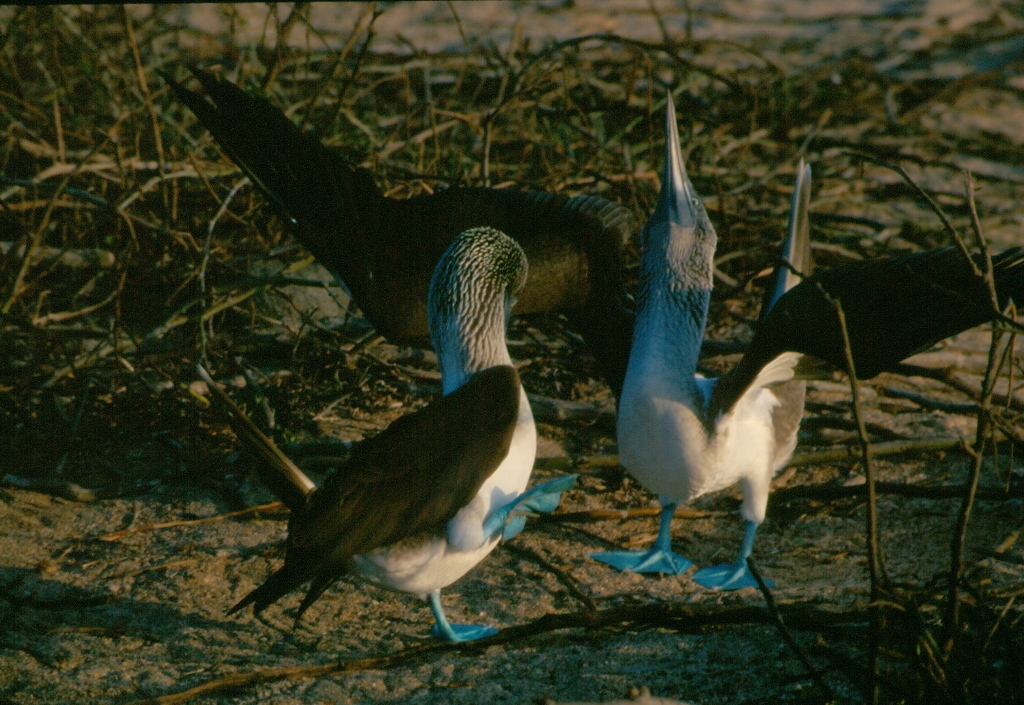 Blue-footed boobies
Blue-footed boobies
Following our encounter with birds, we came to a place from which we could observe a sea “geyser.” From the height at which we stood, we looked at a volcanic rock plateau that protruded from below our feet into the ocean. Erosion has made holes and shafts in the rocky plateau and as a large wave hit the front part of the plateau, the water would dash through the shafts and the pressure would shoot the water upwards through a narrowing with a roar, thus creating a natural geyser imitation that would sometimes be over 10 m high. We stood there for a while, admiring the beauty and power of a natural phenomenon, after which we returned following a long path to a place where Carlos awaited us.
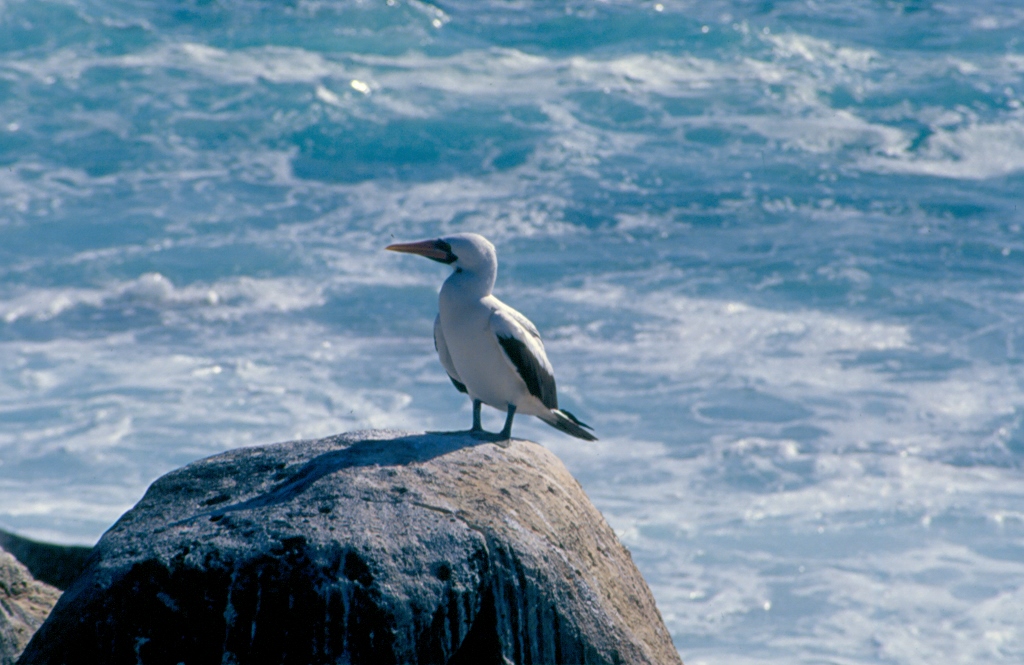 Masked booby
Masked booby
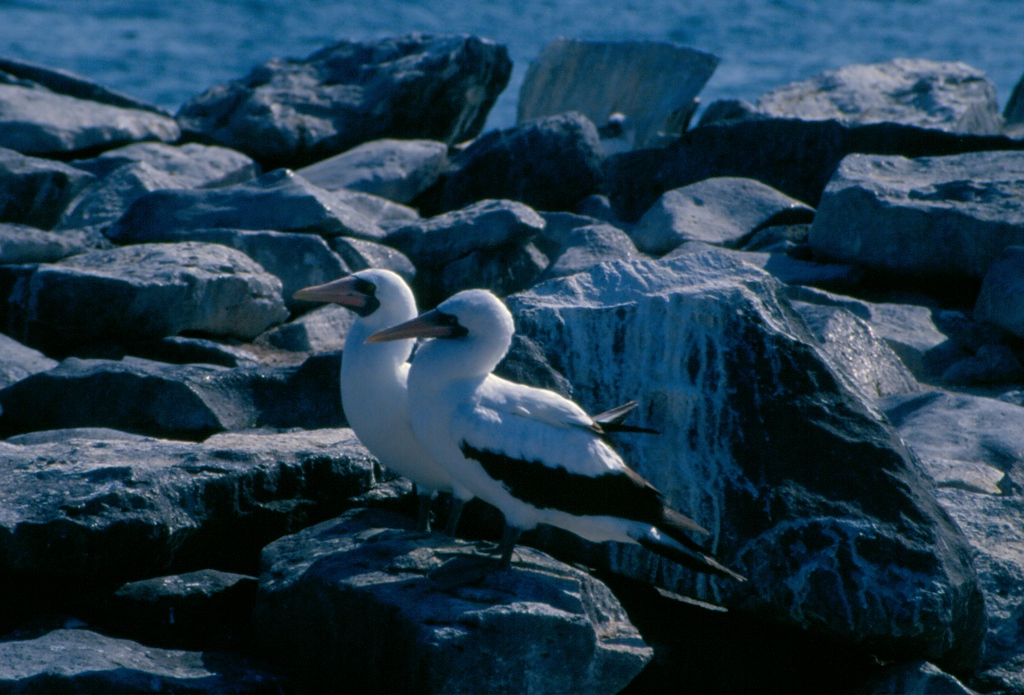 Masked boobies
Masked boobies
The ship continued to sail in the direction of the island Floreana and we all enjoyed being lazy on the canopy-covered platform that was on the prow when Milton suddenly started to blow the ship’s horn like mad. We were all confused, as we saw nothing around us, not a single ship and our own ship was just sailing forward in the same rhythm, but Milton was adamant and kept blowing the horn. Marco, the mechanic and the cabin boy, bent over the bow and then turned towards us with his white teeth shining in a broad smile. A pod of dolphins! We all rushed to the bow and enjoyed our wonderful entourage – a dozen of dolphins swam and jumped alongside the ship. They soon left us, though, and we went back to being idle.
Towards the evening we anchored by Floreana. Because of my bad experience with the banging door of the previous night, I realized it was high time to negotiate with captain Milton who actually didn't need much convincing before allowing the mattress from my berth to be transferred to the passage in front of the cabin with the steering-wheel, instruments and controls, so I spent the rest of the night under the open sky. The only problem with that was that I actually had to go to sleep. With no civilization for at least 1000 km, which is the distance between the Galapagos and the continent, the sky full of stars was magical and it is a true pity that I could not spend the entire night enjoying the view. Following the Ursa Major constellation, I tried to establish the direction of the north through the position of the North Star, but it was not visible since from that latitude it was hidden just slightly below the horizon. The Moon had just started to wax, so there was no distraction to the myriad of stars and the always impressive Milky Way that spread across the sky. That first night I saw as many as four falling stars and following old superstition I started making wishes, but just as I ran out of wishes, they stopped falling and I fell asleep.
But, just beforehand, that evening I started with my Galapagos witch career. Namely, I am a keen and dedicated student of Tarot and each evening I was there I did divination. One evening, Marco, the cabin boy, saw me and then the next day he asked me shyly if I would read Tarot for him. I normally don’t do this for others, since for me Tarot is my own intimate love and passion, but I could not resist the challenge. I could see in him a sincere interest and also it was an excellent opportunity for me to practice my Spanish. We set the time for the reading and he also brought Eusebio along and when the cat got out of the bag, I had to do the readings for the entire crew. When I first decided to do the reading for Marco, I didn’t even dream of how fantastic opportunity this would be for me to get to know Ecuadorians in a very specific manner. By definition, the questions concerned issues that are usually not discussed with tourists and it was interesting to see how they perceive love (yes, most of the questions were in connection with love). Although Latin Americans are predominantly of catholic faith, the strict religious rules do not seem to apply. The power of urges seems much too strong in them! Regardless of the strict catholic norms, they still have multiple marriages, extramarital affairs, numerous children, in and out of wedlock, whom they don’t even know or meet them in their later years, so, as far as I could see – nothing of one single marriage under the auspices of God until death do us part. Still, no matter how seriously I take Tarot and everything related to it, I almost burst out laughing when one of my “clients” posed one of his questions. At the time, he was in his 70’s, had already been living for 5 years with a woman 20 years his junior, she was his fifth wife, although he still had not divorced his third one, he liked living with her and yet he wanted to know whether she loved him! Admittedly, there was a sub-question in the air as to whether she loved him for himself or because of his money. As if that mattered! If he liked living with her, and he did, why did it matter whether she truly loved him or not? And yet, the question of love seemed really important and significant to them. On some other occasion, Milton told me how, when he goes to a club, he is surrounded by many girls, but he would love to find only the one that would – love him!
After my first night under the open sky and the breakfast the following day, we were taken to the shore of the bay in which we had anchored – Bahia de los Correos or the Post Bay. This is the place where perhaps the most unusual “post office” in the world is located. At the time when there was no post mail as we know today, i.e., several centuries ago, an inventive Englishman installed a wooden barrel with a small door on it not far from the coast. The idea was that whoever wanted to write to someone should put their mail there and the passing ships would collect it and forward it on once they got back home. This functioned fantastically and people decided to preserve the custom. Nowadays, people usually leave tourist postcards and when somebody from their country or city passes by, they take the post and forward it on once back at home. Just like the ships in the old days. As an experiment, my friend put in a postcard in my name, since I was the only one of us four living in Serbia, because he wanted to see when somebody else from my country would get there. To my horror, the postcard arrived soon enough, but sent from the USA. That was not the idea, it was not nice (although clearly well-intentioned) and did not help our experiment at all. On the other hand, that was the only postcard posted in the Galapagos that has ever reached any of us. In other words, the barrel-post is more efficient that the regular mail from the Galapagos. Close to the “post office” we visited one of numerous lava tunnels. These are tunnels that have been created when lava flows cooled down and solidified, and when gasses trapped there leaked out. Some of them are short and resemble collapsed caves, while some of them are longer and really look like proper tunnels. We got into this one by climbing down some wooden ladders and it seemed like proper cave exploration. We went to a section that was slightly submerged under sea water and although there was no visible exit, some of us got into the water and walked around for a little while.
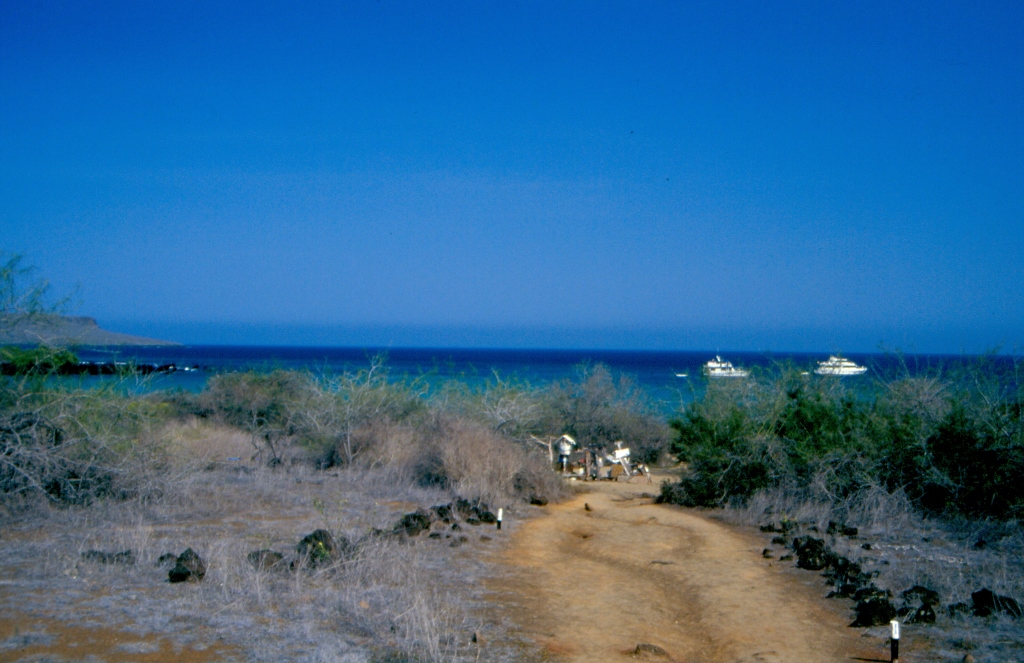 Bahia de los Correos
Bahia de los Correos
The continuation of our journey took us to the place called Punta Cormorant on the island Floreana. What makes the beach we landed on characteristic is the brownish-green colour of its sand. The green sand hue comes for the semiprecious stone olivine, better known as peridot. It is a very rare and valuable semiprecious stone that was turned into sand here by erosion and only very tiny pebbles made of it could be seen on the beach.
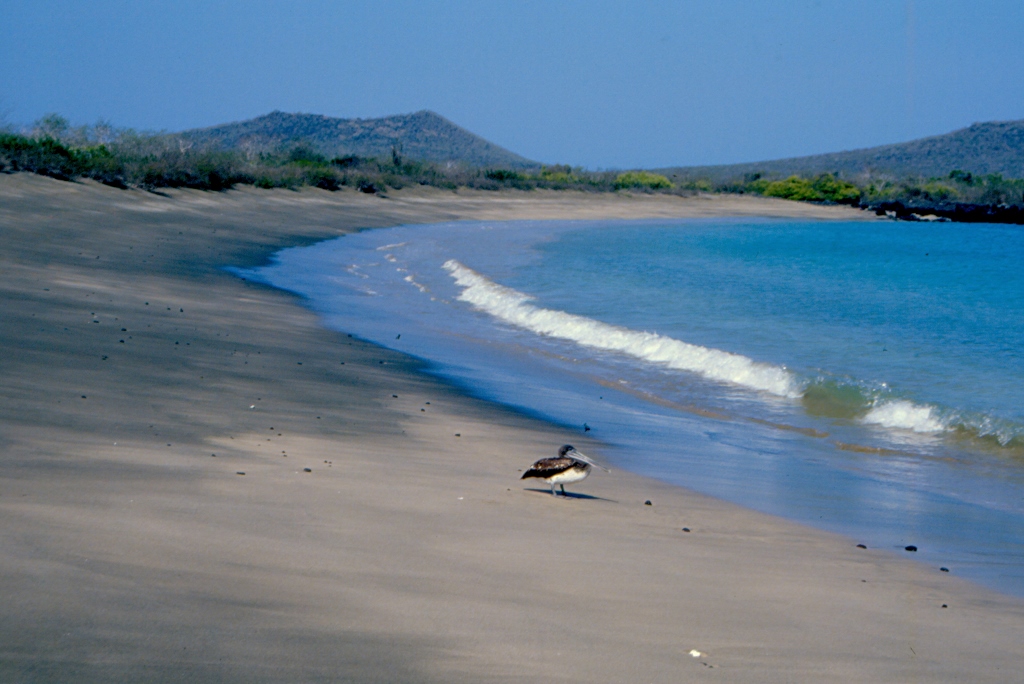 A pelican on the beach of Floreana island
A pelican on the beach of Floreana island
The main reason for our coming here, though, was not this beach, but rather another one some ten minutes on foot away which we reached by going across a promontory that projected into the sea like a finger. The beach that was on the other side was made of completely white sand and it was truly incredible that such different sands can be found on two beaches that are practically one next to the other. That other beach was also significant for us because of the schools of rays swimming in its shoals. This was a very poisonous species and Bryan from California advised us how to actually go into the shallow waters in order to see the rays better without having an unpleasant encounter with any of them. Apparently, a friend of his had the experience and although the poison is not lethal, nonetheless, the pain that followed was something worst that the poor man had ever experienced. After such a warning, we did venture into the knee-deep waters in order to get closer to the rays that glided past us.
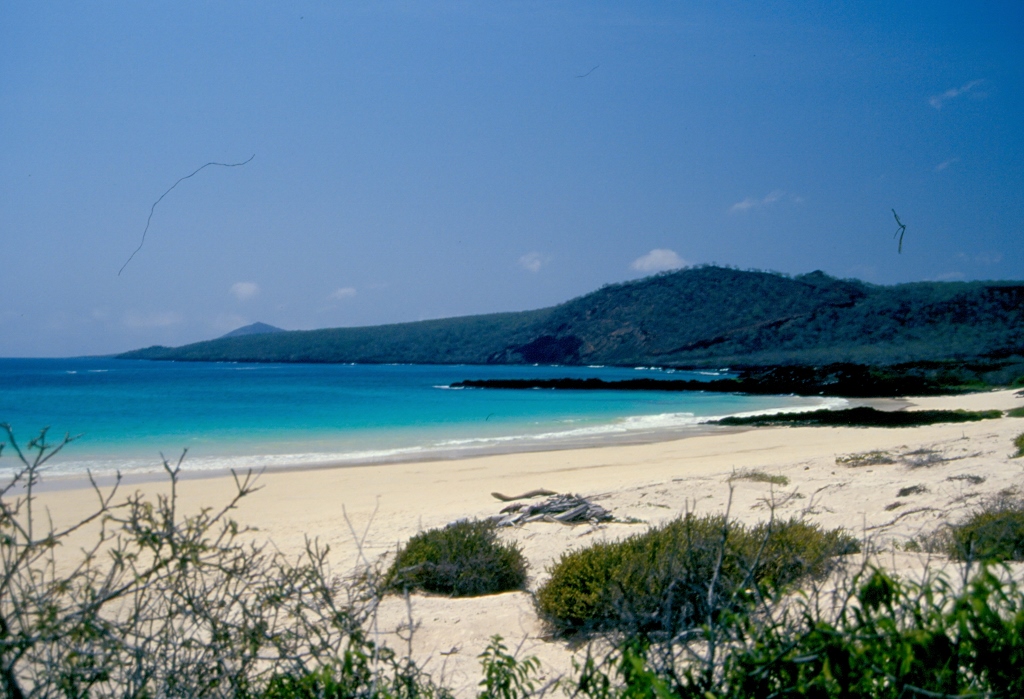 Beach with rays, Floreana
Beach with rays, Floreana
Soon, the curiosity waned, plus we had an even bigger challenge ahead of us, so we went back to the ship, got ready for snorkelling and Carlos took us in the dinghy to the Devil’s Crown. This is the very top of an underwater volcano with only volcanic rocks scattered in a perfect circle protruding from the depths, like some black and broken teeth. First we went in the dinghy above the centre of the crater that is rather shallow and actually covered by sand and then Carlos took us to the outer side of the Corona del Diablo. This was where we jumped into the water, with Carlos remaining nearby for all those who got tired. I separated a little from the group and started to enjoy myself. On the outer side, one could get the glimpse of the depths, for the water was dark and chilly. First I saw a school of king angelfish and then a lot of gray fish with yellow tails, yellow-tail surgeonfish. And then I saw, right below me, a white-tip shark. Cesar, who always snorkelled with us and was also our fish guide, had told us that there were white-tip sharks there, but that they were not dangerous, so it was not a problem to be in the water near them. Still, it was a specific experience for me, a concurrent feeling of excitement and trepidation. There are a lot of hammerheads in the Galapagos, but in order to see them one needs to go to special places and with proper diving equipment. Soon, the white-tip shark disappeared into the depths and I continued to go around the crown entering the centre at some point. Everything was different there. The water was shallow and the sand bottom was whitish, making the water colour also more attractive for ordinary snorkelers like myself. It was also warmer, with more diversity and colour than on the outer side. There were angelfish, as well as parrotfish, boxfish, etc. Starfish were fantastic: brownish-gray covered by a bright red net-like pattern, then complete opposite or with yellow elements. Brilliant! I stayed there and enjoyed for a while, and then we had to move on. In the evening we arrived in the town of Puerto Ayora on Santa Cruz island to get fresh supplies of water and food, and we also spent there the entire following day.
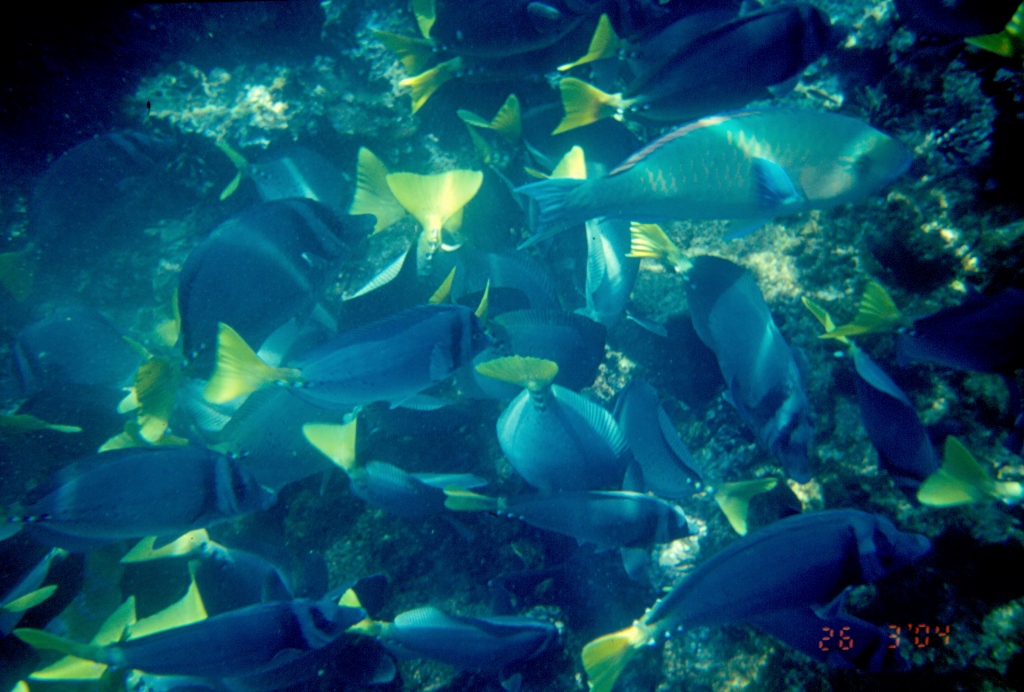 Surgeonfish and a parrotfish
Surgeonfish and a parrotfish
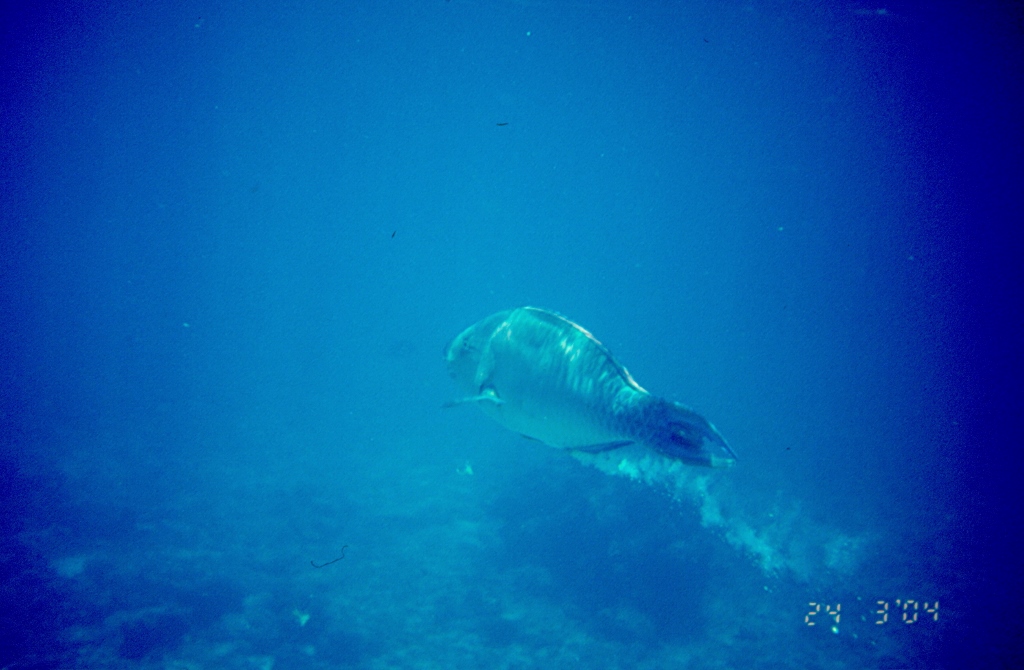 Parrotfish caught in the act
Parrotfish caught in the act